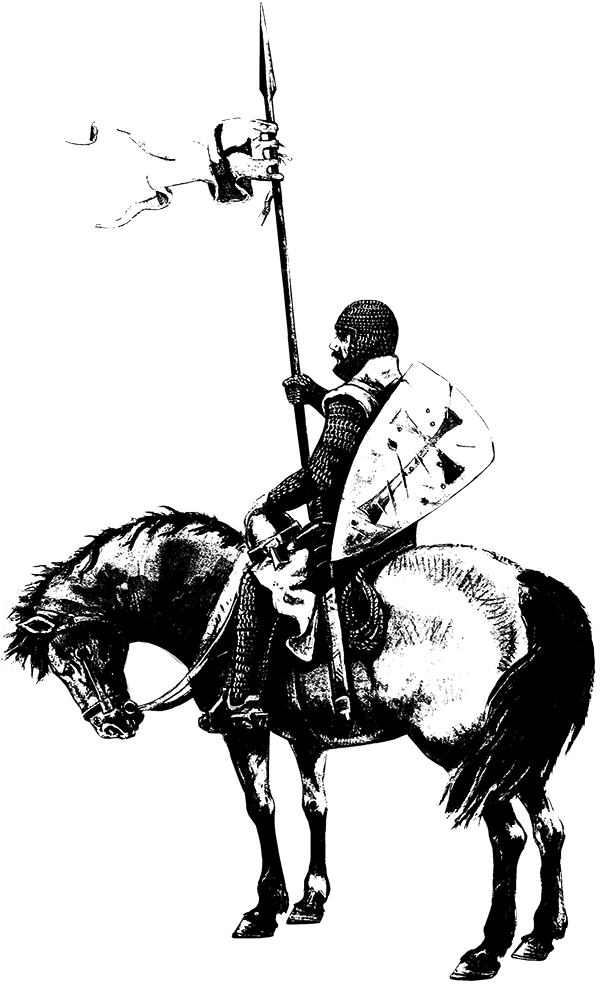 The United Religious, Military and Masonic Orders of the Temple and of St John of Jerusalem, Palestine, Rhodes and Malta in England and Wales and Provinces Overseas
The United Religious, Military and Masonic Orders of the Temple and of St John of Jerusalem, Palestine, Rhodes and Malta in England and Wales and Provinces Overseas
Province of Kent
 Two Knights on a horse - Poor Fellow-Soldiers of Christ and the Temple of Solomon
Two Knights on a horse - Poor Fellow-Soldiers of Christ and the Temple of Solomon
 Here are a number of current explanation of the device on the Templar’s seal, two horsemen on one horse. The explanation that this device is intended to commemorate the poverty of the Order, which could only afford one horse for each pair of Knights, It is flatly contradicted by the Statutes of the Order (drawn up by St. Bernard in 1128) which expressly enjoined that each Knight will be provided with three horses. Even the ‘fraters servientes armiger’, or men-at-arms, of whom a body attended each Knight, were allotted one horse each.
Here are a number of current explanation of the device on the Templar’s seal, two horsemen on one horse. The explanation that this device is intended to commemorate the poverty of the Order, which could only afford one horse for each pair of Knights, It is flatly contradicted by the Statutes of the Order (drawn up by St. Bernard in 1128) which expressly enjoined that each Knight will be provided with three horses. Even the ‘fraters servientes armiger’, or men-at-arms, of whom a body attended each Knight, were allotted one horse each.
In the Foregoing, the stressing of the 'poverty of the Order' is far from the truth. The Order very quickly became one of the richest organisations in Christendom and were virtually Bankers to Kings and Popes. This arose from the fact that all entrants into the Order, from Knights to the most lowly Serving Brother, took vows of chastity and poverty, handing over their lands, money, possessions and even their clothes and arms to the Grand Master of the time. From the moment of their acceptance into the Order, the Grand Master provided them with all their needs: food shelter, clothing, horses, arms, armour, in return for full obedience to the rules of the Order.
These 'Primitive Rules', first promulgated in the year 1129, are still in existence in their medieval French language as 'La Regle du Temple' and have been translated and published as ‘The Rule of the Templars’ (1). In total, there are 686 Rules under the headings of 'The Primitive Rule', 'The Hierarchical Statutes', 'Penances', Conventual Life', 'The Holding of Chapters', 'Reception into the Order', to all of which the Templar must adhere, and an appendix, ‘The Military Manual'.
A short summary of some of these Rules, which apply to the ‘horse’ question, are as follows:
Rule 138: Each Knight Brother should have three horses and one squire and a second squire and a fourth horse at the discretion of the Master, he should have a hauberk, iron hose, a helmet, a sword, a shield, a lance, a Turkish mace, a surcoat, an arming jacket, mail shoes, three knives, a dagger, a bread-knife, and a pocket knife... They may have two shirts, two pairs of (leather) breeches, two pairs of hose, and a small belt over the shirt... and all shall sleep thus, except when ill in hospital, and then only with permission.
But a much more plausible explanation and an actually recorded event, can be found in studying the ‘surprise’ tactics Richard Lionheart employed against Saladin during the 3rd. Crusade 1192.
In ‘The Life of Saladin’ (1137-1193) a translation published in Delhi, India, 1988, Saladin’s chronicler Bahaed-Din Ibn Shaddad (1145-1234) records: "On June 7, 1192, the Crusader army marched to attack the Holy City, (then occupied by Saladin). Richard’s spies reported a long-awaited supply train coming from Egypt to relieve Saladin’s army. When Richard received information that the caravan was close at hand a thousand horseman set out, each of whom took a foot soldier (on his horse) in front of him. At daybreak, he took the caravan unawares. Islam had suffered a serious disaster. The spoils were three thousand camels, three thousand horses, five hundred prisoners and a mountain of military supplies. Never was Saladin more grieved, or more anxious".
In all representations of the scene of two Knights on a Horse both Knights have their shields in their left hand and not on either side of the horse, if you were in a charging position the Knights would attack with their shields on both sides the horse and their weapons ready to strike from either side.
From a Christian perspective a poem call footsteps in the sands by Mary Stevenson describes the scenario of two Knights on a horse.
 One night I dreamed a dream.
One night I dreamed a dream.
I was walking along the beach with my Lord.
Across the dark sky flashed scenes from my life.
For each scene, I noticed two sets of footprints in the sand, one belonging to me and one to my Lord.
When the last scene of my life shot before me I looked back at the footprints in the sand.
There was only one set of footprints.
I realized that this was at the lowest and saddest times of my life.
This always bothered me and I questioned the Lord about my dilemma.
"Lord, You told me when I decided to follow You,
You would walk and talk with me all the way.
But I’m aware that during the most troublesome times of my life there is only one set of footprints.
I just don’t understand why, when I need You most, You leave me".
He whispered, "My precious child, I love you and will never leave you, never, ever, during your trials and testings.
When you saw only one set of footprints, It was then that I carried you."
 This depicts Christ siting behind you to protect your back when are in danger or when Christ sits in front to guide you on your path through life.
This depicts Christ siting behind you to protect your back when are in danger or when Christ sits in front to guide you on your path through life.
It is up to the individual knight to make up his own mine which version of the explanations he wants to believe.
![]()
< back